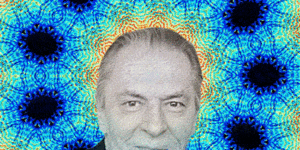The Art of Self Acceptance:
5 Powerful Exercises for Letting Go of Self Judgement and Negative Thoughts
BY DR. RONDALD ALEXANDER
 unconditional self-acceptance begins by looking within and removing those self-judgments keeping you from experiencing it. photo: emoji photocase.com
unconditional self-acceptance begins by looking within and removing those self-judgments keeping you from experiencing it. photo: emoji photocase.com
Many people cling to the myth that those who are successful inevitably feel good about themselves and are free from self-doubt and insecurities. Many clients I work with have résumés, personal achievements, and
reputations that garner the deepest respect and admiration, yet their lack of self-acceptance and negative self-talk is often utterly brutal. Despite their low opinion of themselves, they’ve managed to fashion lives that many would envy. Yet the disconnection between their inner feelings about themselves and their outer success causes them to hold back from making changes that would lead to far greater fulfillment and equanimity. They’ll often remain in a stagnant situation until change is thrust upon them, and then feel overwhelmed by the crisis they face.One of the greatest obstacles to creative transformation and moving deeper into self-acceptance is unwholesome self-judgments, and we all have them. The mind’s ability to generate such judgments is very powerful, because it’s working off old neural programming that must be rewritten again and again before new, more wholesome thought processes can become habitual. With more wholesome thought patterns in place, crisis becomes less overwhelming, and it’s far easier to let go of resistance, tune in to your passions and inner resources, and move forward with self confidence.
“When there exists attachment, contemplate impermanence, unsatisfactoriness, and the No Self.”
— Buddha
Becoming more insightful and reflective through mindfulness practice leads to greater awareness of the unwholesome self-judgments produced by your mind. You may be tempted to judge yourself as a bad meditator, or a failure at fixing your low self-esteem, but what you really are is a person making a long and sometimes arduous journey of self-discovery and self-acceptance. Don’t hold yourself to unrealistic standards and expect to quickly transform what are often lifelong thinking habits.
The object is to stop assigning meaning to these self-judgments, because once you start to give them weight, they begin to weigh you down. Elaborating on these judgments will cause you to feel constricted by your unwholesome thought processes. Your ability to make breakthroughs, weather crises, and begin living more richly and more authentically will increase once you make a conscious decision to let go of unwholesome self-judgments every time you recognize them and move into a space of self-acceptance.
Discovering and Banishing Hidden, Unwholesome Self-Judgments
Some self-judgments are neutral and don’t create strong feelings of anger, joy, sadness, or excitement. They’re simply part of your self-definition, and have no emotional baggage attached to them. For one person, the self-judgments “I’m energized by being around other people rather than by being on my own” or “I’m more comfortable in small groups than in larger ones” might not create any emotional response or inspire any disempowering stories about being extroverted or shy. Yet for another person, the very same self-judgments might elicit powerful emotional responses and extensive ruminating if they bubble up to the surface of awareness and work powerfully against moving into a space of self-acceptance..
 we are often unaware of all the self-judgments that lurk in our subconscious mind and influence our perceptions greatly, keeping us from moving more deeply into self-love and self-acceptance.
we are often unaware of all the self-judgments that lurk in our subconscious mind and influence our perceptions greatly, keeping us from moving more deeply into self-love and self-acceptance.
If you’re not mindful, you may not notice when the thoughts, feelings, emotions, and sensations connected to a seemingly neutral self-judgment are unwholesome. Often, the rational mind strings together a series of distortions, such as “I’m shy, which is why I’ll never find a romantic partner; my shyness makes me unattractive,” or “I’m an extrovert. My mother never liked that about me, and it seemed to embarrass my siblings. I probably made a fool of myself many times, being too eager to connect to other people, who look down on me for being emotionally needy.” You may not even be fully aware that you’re embellishing your self-judgments in an unwholesome way that are counterproductive to self love and self-acceptance.
Through mindfulness practice and self-inquiry, you can render any unwholesome self-judgments neutral and possibly even wholesome: being “self-centered,” focused on resolving inner conflicts, can be seen as negative, but it’s very important at times to direct your attention to yourself and your needs in order to cultivate true and deep self-acceptance. For example, if you consider yourself to have the characteristic of “callousness,” you might reframe it as the quality of courage. If you see yourself as “weak,” consider perceiving yourself as being sensitive to other people’s feelings.
You’ll never rid yourself of your unwholesome self-judgments and be completely free from the suffering they cause you. However, you can alter their quality, learn from them, and either let them go or transform them so that they no longer block you from a sense of well-being, a feeling of spaciousness, and an openness to new possibilities, self love and self-acceptance. Most often, when you let go of your unwholesome self-judgments, you discover aspects of yourself that inspire and vitalize you. You start to have faith that you can live more authentically and richly.A client of mine came to therapy because she was suffering badly from having been let go from several corporate positions and was now was establishing herself as a freelance consultant. She had pervasive feelings of low self-esteem, a lac of self-acceptance and a continual flow of unwholesome thoughts, such as “I can’t earn a good living doing this, because no one will pay me what I was making before” and “Who am I to think I can run my own business?” Despite her obvious ability to procure good jobs, the fact that she had lost so many had shaken her sense of self-worth, even though several of her layoffs were due to corporate restructuring rather than to any failings on her part. Raised in a working-class home, she’d never quite felt she belonged at a major university, where she got her degree, or in a well-paying job with significant responsibilities.
We worked for quite a while to help her uncover and transform, or let go of, her unwholesome self-judgments and accept that there’s an upside and a downside to every quality. Over time, she came to see that the perseverance that had led her out of her small town and to the big city, where she thrived, was still a quality she possessed. She was able to acknowledge how her perseverance had served her, as well as how it had held her back: when her companies had restructured or experienced financial difficulties, her unwillingness to recognize the need to look for a new position elsewhere and embrace the fact that change was in the air had resulted in her staying too long and being laid off. By mindfully accepting that she had the quality of “perseverance,” which she realized could also take on unwholesome aspects and turn into stubbornness and rigidity, she was able to identify ways in which she might maximize its potential for her and minimize its negative effects. This allowed her to break apart the self-judgments she’d created, experience the flow of her inner resources and strength, move into a space of self love and self-acceptance and envision being a successful entrepreneur.
You may not realize that your unwholesome judgments of your qualities are holding you back from creative transformation. By tolerating the discomfort of examining your self-judgments and letting unwholesome thoughts, feelings, and sensations arise, you can drain them of their ability to frighten or stifle you and instead cultivate a deep feeling and reality of self-acceptance. Turning them over to see their flip side allows you to see how you can embrace those qualities, consciously choosing to enhance their positive aspects and limit their negative effects. In a crisis, you can use the wholesome aspects of these qualities to propel you forward out of suffering.
Avoiding Painful Self-Reflection
Some of our self-judgments are so painful to acknowledge that we prevent our conscious mind from bringing them to the surface of our awareness. We sense that, like the visage of Medusa, they would create so much fear and anguish for us that we’d essentially turn to stone, unable to move out of our suffering and into self-acceptance where we want to be. No one wants to face an excruciatingly painful thought such as “I’m a bad parent” or “Important people in my life don’t respect me,” yet such unwholesome and destructive beliefs about ourselves lie within many of us. Our fear magnifies danger out of all proportion.
By using mindfulness and the art of creative transformation, you can face the truth about yourself and hold on to faith that every one of your qualities can be mined for its beneficial aspects. Your deepest, or core, creativity, the fuel for the greatest breakthroughs in personal growth and transformation, will remain buried deep within your psyche until you acknowledge, examine, and then let go of the unwholesome self-judgments that obscure it and the self-acceptance and self-love that we seek.Avoiding the Pain of Self-Discovery
Mindfulness practice breaks down avoidance behaviors, allowing hidden self-judgments to surface. We’re often tempted to minimize their importance, in the vain hope of easing the pain of being aware of our “shortcomings.” Often, my clients take pride in what they call their “self-honesty,” reporting to me that they simply can’t work for anyone else, that they have to be the boss, or that they’re by nature aggressive and even offensive in their interactions with others and that can’t be changed. Their bravado is an avoidance behavior. Underneath their false, external confidence is a fear that they can’t work for anyone else, alter their behavior and take a more effective and nonaggressive approach, or interact with others in a positive, nonoffensive way.
The fear that you can’t change may push you into denial and cause you to minimize the consequences of your unproductive behaviors. Whatever you discover about yourself and however painful your discovery, dramatic breakthroughs into self-acceptance are always possible. Research on mindfulness meditation shows that qualities we once thought immutable that form temperament and character can actually be altered significantly. By retraining your mind through mindfulness practice, you create new neural networks. If you’re aggressive, you can find ways to temper that aspect of yourself, becoming assertive and clear about your boundaries without entering into a competitive and possibly even hostile mind-set that will sabotage you. Even if you’re a lifelong pessimist, you can learn to become more optimistic (Davidson 2000; Siegel 2007).
Transforming Self-Doubt Into Self-Acceptance
As you’ve learned, the first step in dissolving any unwholesome thought, belief, judgment, emotion, or feeling is simply to watch it arise in your mind. Next, you identify it as wholesome, unwholesome, or neutral, and deal with it accordingly. If it’s wholesome, savor it, experiencing it fully and drawing strength and joy from it. If it’s unwholesome, come back to it during and after your meditation, and examine the mind patterns that generated it, consciously reshaping those patterns into ones of self-acceptance and then reinforcing your new ones through mindfulness practice. This process sounds simple, but you may find that the sensations and emotions accompanying your harsh self-judgments are so painful that you quickly find an excuse to end a session or, if you’re not meditating, that you brush away what arises in your consciousness. Yielding to avoidance behaviors blocks the possibility of clearing up any unwholesome self-judgments.
Be assured that even if you were to discover that your unwholesome self-judgment has truth to it, simply making that painful discovery would take you a huge leap forward in your ability to transform that aspect of yourself. Your willingness to acknowledge this painful reality allows you to look at it more objectively and see that there are times when those judgments don’t apply—and in fact, they may not apply most of the time. Knowing this can give you further self-confidence to accept that sometimes you exhibit unwholesome qualities, but you can change that disconcerting reality and move into self-acceptance.
Everyone has qualities worthy of admiration and esteem that serve them well when harnessed. You’ll be better able to claim yours and enhance them once you’ve done the important work of acknowledging, learning from, and letting go of your unwholesome self-judgments. You may want to begin this process by consciously identifying those unwholesome self-judgments that you know have been plaguing you, using the following mindfulness journal exercise to transform them into self-love and self-acceptance.
1. Transform Your Unwholesome Self-Judgments
1. In your mindfulness journal, list what you’ve always thought of as your negative qualities. Include any criticisms others have made of you that you’ve been holding onto, whether it’s something your siblings and peers used to say about you when you were a child, or what your boss told you in your last annual review. Don’t stop to judge whether these judgments are accurate; that step comes next. Simply note what you think of as your flaws.
2. As your discomfort naturally arises, remain present with it. Recognize that it will soon pass away but for now is a valuable tool for helping you in the process of letting go of your unwholesome self-judgments. Let every painful belief about yourself arise, taking your time to become quiet and mindful, opening yourself up to this flow of awareness from your unconscious mind.3. After you’ve written down all the harsh self-criticisms that have come to you, you may want to group them visually, drawing lines and circles to show connections to their origins, such as when your mother told you, “You move too slowly” or your spouse told you, “You procrastinate all the time.” Find the common themes and note them.
4. Next, ask yourself the following questions about each of these unwholesome self-judgments:
1. Is this true and accurate for me right now?
2. Is it true sometimes? Under what circumstances?
3. Was it true in the past, but no longer?
5. If your self-judgment is not true and accurate for you right now, then envision yourself dragging these old beliefs and unwholesome patterns of thought into the trash, as if you were cleaning up your computer’s virtual desktop, removing files that are no longer relevant or useful. Be forewarned that even if you make this choice to delete any particular self-judgment, it will probably continue to linger in your unconscious mind, arising again and again, particularly when you slow down and meditate. However, now you’ll see it for what it is: an unwholesome, unproductive thought that causes pain and suffering and gets in the way of your self-love and self-acceptance. Be mindful of whenever it reemerges, and set it aside without further examination.
If your self-judgment is true, recognize it as an issue you’ll be working with for some time. You can consciously change your tendency to cast that quality in an unwholesome light. Begin to write about ways in which this quality has benefited you or might benefit you in the future. You may even want to use a thesaurus to find words that mean the same thing, because it might shed some light on the various qualities of your self-judgment and how it gets in the way of self-acceptance.
Next, write out an affirmation of the positive aspect of this self-judgment and recite it to yourself several times, while visualizing the positive feeling within your body (this is called an embodiment of the quality), allowing yourself to feel the truth of the statement and anchor the self-acceptance. For example:
1. Unwholesome Self-Judgment
Disorganized
Wholesome Aspect
Creative, not contained by rigid structures
Affirmation
“I embrace my creativity and fluidity.”
2. Unwholesome Self-Judgment
Sarcastic, cruel
Wholesome Aspect
Willing to defend myself and tell it like it is, honest, clever with words
Affirmation
“I am clever, forthright, and strong.”
3. Unwholesome Self-Judgment
Unworthy
Wholesome Aspect
Worthiness, deserving, actualized
Affirmation
“I am worthwhile, I have substance, and I feel full and solid within.”
4. Unwholesome Self-Judgment
Self-critical
Wholesome Aspect
Admiration and confirmation
Affirmation
“I fill myself up with compassion and acceptance, and I affirm myself.”
5. Unwholesome Self-Judgment
Desire
Wholesome Aspect
I have passion and fire
Affirmation
“I admire others and appreciate everybody’s uniqueness, and I aspire to greatness.”
6. Unwholesome Self-Judgment
Envy
Wholesome Aspect
I expect more of myself
Affirmation
“I am satisfied with contentment and equanimity.”
7. Unwholesome Self-Judgment
Sad
Wholesome Aspect
I am wide open with deep feelings.
Affirmation
“My sadness breaks my heart open to feel compassion and grief.”
Allow yourself to experience pride, delight, and comfort as you acknowledge the wholesome aspects of your self-judgment and transform it into self-acceptance.
As you perform this exercise, you may feel that you’re making excuses for yourself, but you’re not. The paradox is that you can’t acknowledge and drain the destructive power of your unwholesome self-judgments until you’re less frightened by them. If you embrace your forthrightness and strength, and practice mindfulness, you’ll notice when you’re tempted to respond to someone with cruelty and sarcasm, and you’ll instantly remember that you want to let go of that old behavior pattern. You’ll begin to enhance the new neural network in your brain that fosters an awareness of your forthrightness and strength, and open up to your compassion and kindness, which themselves lead to self-acceptance. You’ll stop feeling guilty and denying your tendency to be sarcastic, because you’ll be compassionate toward yourself. Your compassion toward others will dissolve your desire to issue a cutting remark. Then, when your spouse or coworker makes a comment that you disagree with or that makes you uncomfortable, you’ll be able to consciously choose a new, more wholesome and productive way of responding, changing the tenor of your relationship with them and fostering better relationships.
If your unwholesome self-judgments are particularly difficult to let go of, take heart in knowing that the approach of mindfulness-based cognitive therapy has been shown to be very effective with the most persistent unwholesome self-judgments that cause depressive thoughts and repeated relapses of clinical depression. In fact, this dual approach is more effective than most other psychotherapeutic approaches, including the use of antidepressant medication alone (Segal, Williams, and Teasdale 2002, 24–25). You don’t have to allow old behavior patterns to sabotage your relationships with others or cause you to avoid addressing problems in a situation, setting yourself up for crisis.
2. Mulching Your Unwholesome Self-Doubt
Mulching has become something of a lost art. A good gardener knows that organic waste material can be placed in a mulch pile, where bacteria will break it down and turn it into fertilizer for growing something new. You can do the same with your unwholesome self-judgments, transforming them into the nutrients that will nourish your new self and help ground you in self-acceptance.
You transform your self-judgments by learning from them and discovering what they have to offer you. Whether it’s an old unwholesome self-judgment that pops up here and there even though you’ve consciously rejected it, or one that you’ve only recently become aware of that’s true and accurate today, the process is the same. Rather than ignore the moldy raspberries in the refrigerator or the dying leaves on your rosebush, you remove them and use them for mulch to enrich your life and allow you to grow something new. Like the painter or songwriter who mines the pain of her past to create a masterful work of art, or the former drug user who uses what he knows about addiction to help others address their own drug use, you may end up reinventing your life. Then again, you may simply discover that examining your thoughts and feelings about yourself yields insights into what you most want in your life, and how you might go about achieving it. Mulching allows you to turn any crisis into an opportunity and to use your unwholesome feelings and thoughts as fodder for personal exploration and to anchor in the reality of self-acceptance.
A client of mine, Alan, was embarrassed at a party after the conversation turned to a subject he felt he couldn’t speak to, because he didn’t have the education that the other party guests had. He explored with me his unwholesome self-judgment that was causing his pain that evening: “I’m unsophisticated.” We talked about how he defined “unsophisticated” and whether or not it truly mattered to him if he couldn’t easily contribute to the kinds of conversations he’d often felt left out of when talking to more-educated people. He rejected the idea that to be educated is to have certain tastes and interests, but said he still felt “unsophisticated”, which clearly got in the way of his self-confidence and self-acceptance.
I asked him, “Are you curious about whether there’s any upside to being ‘unsophisticated’?” Examining that idea, Alan decided that being “unsophisticated” had allowed him to focus on developing knowledge in areas he felt were more important than the topics his friends discussed. It allowed him to experience what Buddhists call “beginner’s mind,” a state of openness to learning that allows us to connect to our core self and its resources instead of closing down our creativity and believing we’ve learned all that we really need to learn.
Alan also realized that he did want to know more about one of the subjects a guest had raised, but had been feeling overextended and unable to devote time to educating himself in that area. He felt his guilt and frustration, and then let it go. He acknowledged that it wasn’t an important enough topic to justify his view of himself as “unsophisticated” or inferior for not knowing more about it, and made a conscious decision to devote a specific block of time to taking a short course on the subject. The feeling of inadequacy that underlay this unwholesome self-judgment was part of his big story, the overarching narrative that he unknowingly created in childhood when he struggled in school and was told by his parents and teachers that he wasn’t “college material.” He recognized that the feeling and self-judgment was simply detritus churned up by his mind, which freed him to move into a much deeper level of self-acceptance.
After consciously deciding that he really didn’t care about “sophistication,” Alan struggled with letting go of the old belief and putting into place a new view of himself. Over time, he was able to use mindstrength to install in his mind this new view and to overwrite “I’m unsophisticated” whenever it came into his awareness. In this way, his self-judgment actually supported his self-development the way nutrients in soil enhance a plant’s growth. He broke down the self-judgment, extricated and used what was of value, and then discarded the rest, ultimately allowing him to experience self-acceptance more fully.
When you mulch your self-criticisms, you bring yourself into balance as you acknowledge the wholesome aspects of a quality as well as its unwholesome aspects, instead of being drawn in to the distorted belief that this quality exists inside you only in its unwholesome aspect. You discover the value in that quality and use it as nourishment while you let go of your negative judgment of it. For example, by discarding a label like “helicopter parent,” and validating your close monitoring and careful guidance of your child, you help her move past the boundaries of her comfort zone and possibly discover that she has strength and coping abilities that neither you nor she had recognized. You acknowledge the unwholesome aspect of “hovering” and consciously choose to cease that behavior whenever you notice it, because you recognize that it doesn’t serve you or your child. This discernment process allows you to transform an unwholesome self-judgment into a useful observation of how you operate, an insight that will help you embrace change and move into self-acceptance.
In a crisis, it’s difficult enough to tolerate the pain of loss without adding in the pain of acknowledging your qualities that sometimes manifest in an unwholesome way. With mindstrength, you’ll be able to handle this extra layer of suffering. If you trust in the art of creative transformation, you’ll feel reassured that this layer will dissipate very soon as a result of your engaging in this mulching process. You’ll recognize that you’re fertilizing and enriching the soil beneath you, allowing yourself to grow a new garden of self-love and self-acceptance. You’ll develop the strength to withstand even the most devastating crisis, because you’ll know that in time, you’ll bring forth something new that’s organic and rich.
The Courage to Uncover Your Unwholesome Self-Judgments
In therapy, I can work with a client to examine the smallest of decisions that people tend to overlook in the course of a day. Cultivate mindfulness, and the witnessing self will arise unexpectedly as you go about your activities, alerting you to your entire mind-body awareness, including your discomfort. You may experience mindfulness as a flashlight that spotlights awareness of your conscience, or as a little voice whispering to you. When you’re engaged in an angry confrontation, you might suddenly realize, “I don’t like this; it’s not good for me or the other person, and I need to stop.” As you talk to your friend about her recent success, you’ll notice as your envy mounts, and you’ll think, “I’m really uncomfortable with what she’s telling me. I need to explore the reason.”
You may choose to take the time out to examine your self-judgments immediately, or you may come back to them later, when you’re alone or with someone on your wisdom council of support.
Wisdom Council of Support
Ask for help from a therapist, mentor, or wise partner from your wisdom council of support, someone who can help you to honestly examine your unwholesome self-judgments.
The following mindfulness journal exercise is one you can also engage in mentally any time you notice that you’re engaging in self-criticism. Until you develop greater mindstrength, you’ll likely silence the witnessing mind that calls attention to your discomfort, and need to explore the incident later, in detail, to discover what unwholesome self-judgments are causing your suffering and keeping your from moving more deeply into self-acceptance. As you continue your mindfulness practice, however, you’ll be able to stop in the moment and quickly go through these five steps, easing your discomfort and letting go of the unwholesome self-judgments that are part of your big story.
3. Discard an Unwholesome Self-Judgment
These are the steps to discarding an unwholesome self-judgment that you know is of no use to you and that causes you anguish. Use your mindfulness journal to work through each step to bring yourself ever closer to full self-acceptance and self-love.
1. Identity and label the judgment. Give it a simple name or theme, such as “inadequate provider,” “insincere,” or “people pleaser.”
2. Discover the quality of the judgment. Ask yourself, “What is this self-judgment causing me to think or feel about myself in this moment?” Does it make you feel ashamed, angry, or guilty, for example? Notice whether the feeling is wholesome and supportive of your well-being, or unwholesome, making it difficult for you to enter a state of spaciousness, openness, trust and self-acceptance.
3. Find a remedy for the unwholesome thought or feeling. Ask yourself, “Would I like to think or feel something different? What thought or feeling could I generate to shift myself out of this unwholesome state?”
4. Formulate a new thought, image, or feeling, and begin to hold on to it firmly. Experience it in your mind’s eye and in your body. Feel a wholesome sensation, such as relaxation, excitement, or expansiveness.
5. Assess whether you’ve shifted. Ask yourself, “Have I shifted out of the feeling, state, or thought that was unwholesome and let go of my negative self-judgment?” If you have, then enjoy the new sensations, feelings, and thoughts you’ve generated as a remedy. If not, go back and repeat steps 1 through 4.
The following Fertile Ground meditation uses guided imagery to help you mulch your self-judgments. It’s a good idea to use this in conjunction with the previous mindfulness journal exercise, because it supports your conscious decision to stop engaging in self-criticism, and actually reprograms the brain into self-acceptance by creating a new, more wholesome experience—albeit one that’s happening in your mind.
4. Fertile Ground Meditation
As you sit, breathing in and out with long, slow breaths, focus your attention on your mind’s eye, the space between your eyebrows that’s also known as the “third eye” or “spiritual center.” Bring mindful awareness to each and every negative, self-judgmental thought that arises, and watch for a theme to reveal itself (such as “bad person,” “insincere,” “inadequate,” and so on).
Notice whether an unpleasant or uncomfortable feeling or sensation accompanies these unwholesome self-judgments. In your mind’s eye, surround your self-judgment with a powerful beam of white light (or, if it’s a sensation, imagine the white light surrounding the area in your body where you’re experiencing it). Focus your mind, controlling this white light as if it were a powerful laser beam. Move the beam and the thought, feeling, or sensation enclosed within its circle of light away from your body and mind and into the earth. Watch as it sinks into the soil, intermingling with the rich, brown earth, which infuses it with nutrients as your laser beam turns into the diffuse, golden light of the sun, expanding outward, enveloping you, and warming the earth.
Bask in this sunlight as you feel roots beginning to extend downward from your feet, reaching into the nourishing earth and stretching outward. Then, drink in the healthy nutrients in that soil, pulling them up through your roots. Enjoy the feeling of strength that you create as you draw in power and nourishment, feeding your self-acceptance.
5. Wholesome Memories as Antidotes
Memories can be greatly distorted by strong, painful emotions that caused you to create unwholesome, distorted self-judgments. Returning to the original trauma from the safety of the present, particularly with a supportive therapist at your side, can allow you to look again at how events unfolded, using your logical mind to make sense of what you see with your mind’s eye. When immersed in the original experience, you probably overlooked evidence that contradicted your emotional reality. As I mentioned before, when the children in my first-grade class laughed at my slurred speech that awful day when I was forced to speak in front of them, my emotional reality was that everyone laughed and no one showed support. In reality, such extremes are unlikely. In returning to such a memory, you might remember that one child shushed the others or that the teacher scolded those who were laughing. As you recall this evidence that the incident wasn’t entirely negative, you can draw strength from the memory of someone’s stepping in or your finding unexpected strength. Rather than allow a painful past experience to keep you in a state of contraction, you can remember its positive aspects and use them to give you courage and move more deeply into self-love and self-acceptance.
The mind has the marvelous capacity to experience emotions connected to a prior memory over and over again, each time you recall that memory. When you close your eyes and imagine yourself standing at the shore of a lake, happily tossing in stones with your grandfather at your side, you recreate the feelings of contentment and love. You can use such a wholesome memory as an antidote to emotional pain whenever you feel unloved or insecure.
When a client has an unwholesome self-judgment, I help her experience its wholesome antidote. For example, an interior designer I work with felt that she wasn’t unique or special. I knew from our sessions that this belief was holding her back from expanding her business in a creative way, which she needed to do in order to meet the goals she’d set for herself. I asked her to recall a time when she felt unique or special.
Sometimes my clients insist that they never, not for a moment, felt a particular wholesome quality, but I always press this point, because I know that with some effort, they can find one, however small. I tell the client that it’s as if his computer has given him the error message “file not found” because he’s searched for it in the wrong area of his hard drive. Through mindfulness meditation, we can recover such moments that the conscious mind has forgotten and “restore the file.” Once you find and restore that file, you can reprogram your belief system, consciously choosing to lay a new neural network that reinforces self-love and self-acceptance. However, if you decide to retain that file, you reinforce the old unwholesome belief, ensuring that it will affect your self-image in the future and limiting your opportunities for creative transformation that would lead to deeper fulfillment.
You can return repeatedly to this wholesome memory, all the while using it as a positive antidote. When you do, you’ll reinforce a new, consciously chosen, wholesome self-judgment that encourages self-acceptance. My client was able to access a memory of putting her senior art project on display for the class, and the tremendous admiration and respect her classmates showered on her. Each time she recalled this memory, it re-created in her feelings of being talented, creative, and special.
Creating a New Memory
Another technique for transforming an unwholesome self-judgment into a wholesome one is to consciously rewrite a traumatic memory. Doing so lessens the intensity of the unwholesome feelings attached to it and lays new neural networks for remembering a positive, enhancing experience (albeit one created in the imagination) that cements in self-acceptance. By creating this healing memory, you ensure that whenever the original memory arises in your awareness, it won’t cause you as much pain as it used to.
A Memory Made Wholesome Meditation
After meditating for several minutes, turn your mind’s eye to the scene of an upsetting memory, recalling exactly where you were, how you felt, and any sensory experiences you had at the time (remembering the sensory aspects will help you remove any unwholesome feelings that come up when you have similar experiences in the future, for instance, if you usually become agitated when it rains, because you associate it with that unpleasant memory). Put yourself completely in the scene.
As the scene starts to unfold, imagine yourself being drawn upward and backward by an invisible source that deposits you in a balcony seat from which you gaze down at the drama before you. Be aware that you’re writing the script of this play, and begin to rewrite it. Imagine that in the moment of your embarrassment, the people around you express support, smiling and encouraging you to continue.
Experience the discomfort of this moment mingling with your rising courage, and allow yourself to breathe deeply. Move the feelings through your body as you rewrite the scene to unfold in a way that alleviates your discomfort and makes you feel reassured of being loved and accepted by the people around you.
Letting Go of the False Self and “Becoming Nobody”
The false self, also called the “ego” or the “egoic mind,” is the self we identify with when we’re focused on our own needs or importance. The false self is not “bad,” but identifying solely with this self, rather than the core self, leads to unwholesome thoughts, feelings, and behaviors. The more we engage in egoic mind, the harder it is to handle a crisis. The ego must move out of the way if we’re to immerse ourselves in the three-step process of creative transformation. In the state of open mind, the ego’s voice is but a whisper, drowned out by the call of our soul, which is always nudging us towards greater self-acceptance.
The false self is overly influenced by external voices that we internalize, voices that say “You aren’t good enough unless you…” or “You’ll suffer unless you…” Fear dominates the thinking of the false self and causes us to become self-absorbed, defensive, or overly identified with our roles and situations. When change comes, the false self is alarmed and urges us to resist in an attempt to avoid suffering.
To prevent the false self from taking charge, spiritual teacher Ram Dass suggests the dramatic step of an advanced practice he calls “going into nobody training” (Dass 2007). “Becoming nobody” means letting go of your preconceived notions about your roles and practicing open mind, allowing yourself to discover what’s beyond those roles that the false self fiercely clings to, because even the most positive role can limit us and hold us back.
Raised in a prominent Boston family, Richard Alpert knew very early in his childhood that his family expected him to follow in his father’s and grandfather’s footprints. He went on to become a psychologist and professor at Berkeley and Harvard in the 1960s, but was fired after his experiments with LSD at Harvard. It was a devastating blow, because he was completely identified with being a well-respected psychologist, author, and professor. However, because of LSD, he had experienced open-mind consciousness, so he was ultimately able to break away from this overidentification with the roles he’d played as a psychologist and professor, and let go of his parents’ expectations, which had caused him to walk this particular path. Only then was he able to forge a new life as a spiritual teacher, and develop a new identity as Ram Dass. He came to realize that despite all the trappings of success, including having his own private plane and the admiration of his students, his former life had made him profoundly unhappy, an uncomfortable truth he’d avoided facing for years. The crisis of loss made him realize that though the mandala he’d created may have seemed wholesome and good, it didn’t represent the calling of his soul. “Becoming nobody,” silencing his false self, allowed him to access his core self and form a new, far more fulfilling mandala for himself.
Inside all of us lie possibilities that might sound preposterous to us in the present moment. To access them, we must undergo the art of creative transformation.
This article on cultivating self-acceptance and overcoming self-judgement is excerpted with permission from Dr. Ronald Alexander’s book, Wise Mind, Open Mind: Finding Purpose and Meaning in Times of Crisis, Loss, and Change (New Harbinger Publications, 2009).
About The Author
Ronald Alexander, Ph.D. is a mind/body psychotherapist, international leadership consultant, and the Executive Director of the OpenMind Training Institute in Santa Monica, a leading-edge organization that offers personal and professional training programs in mind-body therapies, transformational leadership, and mindfulness. He is the author of the widely acclaimed book Wise Mind, Open Mind that provides practical and innovative applications to help us through challenging times. Visit his website: ronaldalexander.com





















